Journal Description
Dentistry Journal
Dentistry Journal
is an international, peer-reviewed, open access journal on dentistry published monthly online by MDPI.
- Open Access— free for readers, with article processing charges (APC) paid by authors or their institutions.
- High Visibility: indexed within Scopus, ESCI (Web of Science), PubMed, PMC, and other databases.
- Journal Rank: JCR - Q1 (Dentistry, Oral Surgery and Medicine) / CiteScore - Q2 (General Dentistry)
- Rapid Publication: manuscripts are peer-reviewed and a first decision is provided to authors approximately 21.5 days after submission; acceptance to publication is undertaken in 3.5 days (median values for papers published in this journal in the first half of 2025).
- Recognition of Reviewers: reviewers who provide timely, thorough peer-review reports receive vouchers entitling them to a discount on the APC of their next publication in any MDPI journal, in appreciation of the work done.
Impact Factor:
3.1 (2024);
5-Year Impact Factor:
3.3 (2024)
Latest Articles
Augmented Reality in Implant and Tooth-Supported Prosthodontics Practice and Education: A Scoping Review
Dent. J. 2025, 13(9), 435; https://doi.org/10.3390/dj13090435 (registering DOI) - 21 Sep 2025
Abstract
►
Show Figures
Background: Augmented reality (AR) is revolutionizing implant and tooth-supported prosthodontics (ITSP) through enhanced precision, workflow efficiency, and educational outcomes. This scoping review systematically evaluates AR’s clinical applications, educational impacts, and implementation challenges. Methods: Following PRISMA-ScR guidelines, comprehensive searches were conducted in PubMed, Scopus,
[...] Read more.
Background: Augmented reality (AR) is revolutionizing implant and tooth-supported prosthodontics (ITSP) through enhanced precision, workflow efficiency, and educational outcomes. This scoping review systematically evaluates AR’s clinical applications, educational impacts, and implementation challenges. Methods: Following PRISMA-ScR guidelines, comprehensive searches were conducted in PubMed, Scopus, Web of Science, and Embase (2015–2025) for peer-reviewed studies on AR in ITSP. Eighteen studies met inclusion criteria after dual independent screening. Data extraction focused on clinical outcomes, educational benefits, and technological limitations. Results: AR applications demonstrated: ITSP Practice: Submillimeter implant placement accuracy (0.42–0.69 mm entry deviation; p < 0.001 vs. freehand), 30% faster intraoral scanning (44 s vs. 63 s), and 37% reduction in preparation errors (p < 0.05); ITSP Education: 22–30% faster skill acquisition (p < 0.05) and 99% reduction in assessment time (10.5 s vs. 2 h/case). Key Gaps: Limited to two randomized controlled trials (RCTs), hardware costs ($3500–$10,000), and lack of standardized validation protocols. Conclusions: While AR significantly enhances ITSP precision and training efficiency, widespread adoption requires longitudinal clinical validation, cost-effectiveness analyses, and interoperable digital workflows.
Full article
Open AccessArticle
Temporomandibular Disorders in Professional Scuba Divers—A Cross-Sectional Study
by
Ivica Pelivan, Joško Viskić and Nikša Dulčić
Dent. J. 2025, 13(9), 434; https://doi.org/10.3390/dj13090434 (registering DOI) - 21 Sep 2025
Abstract
Objectives: Most of the published literature on this topic argues about painful teeth, masticatory muscles, and/or temporomandibular joints in scuba divers. This study aimed to determine the possible differences in the prevalence of TMD between the diver population and the general population. Methods:
[...] Read more.
Objectives: Most of the published literature on this topic argues about painful teeth, masticatory muscles, and/or temporomandibular joints in scuba divers. This study aimed to determine the possible differences in the prevalence of TMD between the diver population and the general population. Methods: This was a cross-sectional epidemiological study. The standardized RDC/TMD protocol was used for both the study and the control group. A total of 84 individuals were randomly selected to participate in the study: 55 divers (study group) and 29 individuals from the general population (control group). Results: There was a significant difference in the group 2 and group 3 RDC/TMD Axis I diagnoses between the study and the control group. Logistic regression analysis showed that the diver population was 15.8 times more likely to develop a group 2 left joint and 12 times more likely to develop a group 3 right joint diagnoses than the general population. The RDC/TMD Axis II diagnoses were also significantly higher in the study group than in the control group, whereby the divers were considerably older and predominantly male. Conclusions: A higher prevalence of group 2 (disk displacements) and group 3 (other common joint disorders) diagnoses was found in the divers. However, these results should be taken considering the limitation that there was a lack of age and gender matching between the groups, which can cause confounding.
Full article
(This article belongs to the Special Issue Masticatory System Disorders: Integrative Approaches to the Temporomandibular Joint, Muscles, Occlusion and Beyond)
►▼
Show Figures

Graphical abstract
Open AccessReview
Treatment Options in Impacted Maxillary Canines: A Literature Review
by
Saverio Ceraulo, Antonio Barbarisi, Beatrice Oliva, Sharon Moretti, Gianluigi Caccianiga, Dorina Lauritano and Roberto Biagi
Dent. J. 2025, 13(9), 433; https://doi.org/10.3390/dj13090433 - 18 Sep 2025
Abstract
Background: Impaction of maxillary canines is a frequent clinical challenge in orthodontics. Early diagnosis is key to effective management. Methods: This narrative review included studies published from 2004 to 2024. An electronic search was conducted in PubMed, Scopus, and Google Scholar
[...] Read more.
Background: Impaction of maxillary canines is a frequent clinical challenge in orthodontics. Early diagnosis is key to effective management. Methods: This narrative review included studies published from 2004 to 2024. An electronic search was conducted in PubMed, Scopus, and Google Scholar (September–November 2024), using predefined eligibility criteria. The selection and drafting were completed in the following months. Studies involving orthopedic, orthodontic, or surgical-orthodontic management of impacted maxillary canines were included. Case reports and procedures limited to avulsion or transplantation were excluded. Results: A total of 10 studies were analyzed, comprising 5529 patients, of whom 2530 met the criteria for treatment-specific analysis. Surgical exposure with orthodontic traction was the most frequent treatment (72%), followed by monitoring (12%), maxillary expansion (6%), and extractions (10%). Interceptive approaches were mainly applied in patients aged 7–18 years, with favorable outcomes especially before age 12. In adults, more invasive treatments were required, often with reduced success rates. Conclusions: Early diagnosis and interceptive extraction of deciduous canines reduce treatment complexity and improve success. Therapeutic outcomes are strongly influenced by patient age, tooth position, and angulation. A structured, radiographically guided approach, supported by the proposed decision-making flowchart, may optimize clinical outcomes. However, heterogeneity of included studies and lack of long-term follow-up limit the strength of available evidence.
Full article
(This article belongs to the Special Issue Feature Review Papers in Dentistry)
►▼
Show Figures

Figure 1
Open AccessCase Report
Multifocal Oral Mucosal Melanoma with an Atypical Clinical Presentation
by
Klaudia Podlińska, Monika Monist, Magdalena Sławińska and Wojciech Popowski
Dent. J. 2025, 13(9), 432; https://doi.org/10.3390/dj13090432 - 18 Sep 2025
Abstract
Background: Oral mucosal melanoma (oral malignant melanoma—OMM) is a rare malignant neoplasm. It arises from the proliferation of atypical melanocytes—cells derived from the neural crest that produce melanin. Unlike cutaneous melanomas, which are etiologically linked to ultraviolet (UV) radiation exposure, the risk
[...] Read more.
Background: Oral mucosal melanoma (oral malignant melanoma—OMM) is a rare malignant neoplasm. It arises from the proliferation of atypical melanocytes—cells derived from the neural crest that produce melanin. Unlike cutaneous melanomas, which are etiologically linked to ultraviolet (UV) radiation exposure, the risk factors for mucosal melanomas remain poorly defined. According to the World Health Organization (WHO), these tumors predominantly affect older individuals, with peak incidence occurring in the seventh decade of life and are rarely observed in the first three decades. The primary treatment modality for patients with mucosal melanoma is radical surgical excision with clear margins. The 5-year overall survival rate for OMM ranges from 20% to 50%. Case Presentation: This article reports an atypical clinical manifestation of oral mucosal melanoma in a 99-year-old patient who presented to the Department of Oral Surgery at the University Dental Center, Medical University of Warsaw. The nonspecific clinical appearance did not initially suggest a melanocytic lesion. A definitive diagnosis was established through histopathological examination, which subsequently guided the treatment plan. Conclusions: This report highlights the necessity of performing microscopic evaluation even for lesions with a nonspecific or non-suspicious appearance, underlines the importance of regular dental check-ups, and stresses the need to strengthen oncological vigilance among dental practitioners.
Full article
(This article belongs to the Special Issue Dental Oncology)
►▼
Show Figures
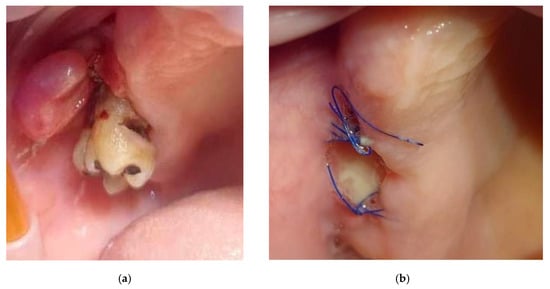
Figure 1
Open AccessArticle
Enamel Surface and Elemental Changes Following In Vitro Bleaching: A SEM-EDS Approach
by
Berivan Laura Rebeca Buzatu, Ramona Dumitrescu, Magda Mihaela Luca, Roxana Buzatu, Atena Galuscan, Vanessa Bolchis, Gabriela Vlase, Titus Vlase and Daniela Elisabeta Jumanca
Dent. J. 2025, 13(9), 431; https://doi.org/10.3390/dj13090431 - 17 Sep 2025
Abstract
►▼
Show Figures
Background and Objectives: Chairside bleaching can alter enamel morphology and mineral content. This in vitro study compared surface changes and elemental shifts after three in-office protocols using scanning electron microscopy (SEM) and energy-dispersive X-ray spectroscopy (EDS). Materials and Methods: Forty-two human premolars/molars were
[...] Read more.
Background and Objectives: Chairside bleaching can alter enamel morphology and mineral content. This in vitro study compared surface changes and elemental shifts after three in-office protocols using scanning electron microscopy (SEM) and energy-dispersive X-ray spectroscopy (EDS). Materials and Methods: Forty-two human premolars/molars were sectioned; matched halves served as control or received Opalescence Quick 45% carbamide peroxide (CP), Opalescence Boost 40% hydrogen peroxide (HP), or BlancOne Ultra+ 35% HP with light activation. Gels were applied per manufacturers’ instructions. SEM assessed topography (×500–×1100); EDS quantified atomic percent of O, Ca, P, C and trace elements. One-way ANOVA compared Ca and P between bleached groups (α = 0.05). Results: Controls showed compact surfaces with preserved Ca and P. After Quick, SEM revealed roughness, fissures and microcracks; Ca fell from 11.5 to 12.5 to 9.53–11.73 at% and P from 7.5 to 8.9 to 7.41–8.59 at%. Boost produced mild superficial restructuring and granular deposits with variable Ca 13.80–27.94 at% and P 7.32–14.65 at%. BlancOne Ultra+ caused diffuse erosion and loss of prismatic clarity with marked demineralization (Ca 1.42–7.85 at%, P 1.22–6.71 at%); C rose locally to 46.61 at%. Across bleached groups, Ca and P differed significantly (both p < 0.001). Oxygen remained dominant (~39–50 at%) in all spectra; occasional Al/Si/Cl/K likely reflected residues or preparation artifacts. Conclusions: All protocols produced surface and compositional alterations, with a severity gradient: BlancOne Ultra+ > Boost > Quick. High-concentration, light-activated HP yielded the largest Ca/P losses. Clinically, neutral-pH, non-activated or chemically activated regimens and immediate post-bleach remineralization should ideally be used when feasible, particularly before adhesive procedures.
Full article
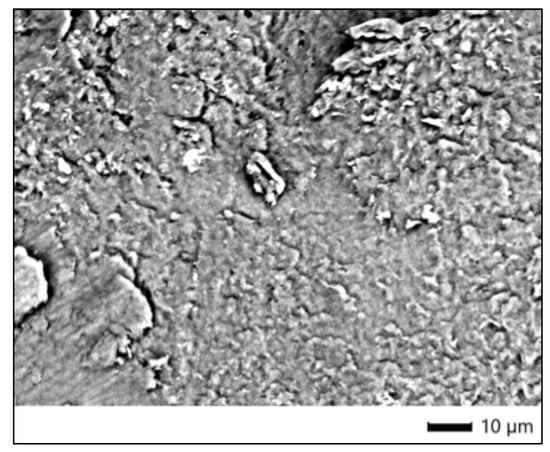
Figure 1
Open AccessArticle
Technical Complications and Marginal Bone Loss Depending on the Crown Material of Dental Implants in the Posterior Region: A 3-Year Randomized Clinical Study
by
Sigmar Schnutenhaus, Marla Weinmann, Max Römer and Ralph G. Luthardt
Dent. J. 2025, 13(9), 430; https://doi.org/10.3390/dj13090430 - 17 Sep 2025
Abstract
Background/Objectives: This single-center, randomized controlled clinical trial evaluated the impact of two crown materials—lithium disilicate (LS2) and a polymer-infiltrated hybrid ceramic (HC)—on the marginal bone loss (MBL) and the technical complications in implant-supported single-tooth restorations over a three-year period. Methods: Sixty patients with
[...] Read more.
Background/Objectives: This single-center, randomized controlled clinical trial evaluated the impact of two crown materials—lithium disilicate (LS2) and a polymer-infiltrated hybrid ceramic (HC)—on the marginal bone loss (MBL) and the technical complications in implant-supported single-tooth restorations over a three-year period. Methods: Sixty patients with posterior single-tooth gaps were randomly assigned to receive either LS2 or HC crowns on iSy (Camlog) implants. All of the restorations were fabricated as CAD/CAM-based hybrid abutment crowns bonded to prefabricated titanium bases. Standardized radiographs were taken at the baseline (T0) and at three years (T1) to assess the MBL using ImageJ software. The technical complications were prospectively recorded. The data analysis was descriptive and exploratory. Results: Fifty-eight cases were available for the final evaluation. The three-year implant survival rate was 100%. The mean marginal bone remodeling was minimal (mesial: LS2 0.15 mm, HC 0.08 mm; distal: LS2 0.13 mm, HC 0.12 mm), with no statistically significant intergroup differences. Bone apposition was observed in 74.1% of the cases. The male patients showed a significantly greater mesial bone loss (p = 0.024). Technical complications occurred more frequently in the HC group, including crown fractures (25%), decementation (17.9%), and screw loosening (14.3%). In the LS2 group, only screw loosening (12.5%) was observed. Conclusions: The lithium disilicate-based hybrid abutment crowns demonstrated a high clinical reliability with stable peri-implant bone and fewer technical complications over three years. In contrast, the hybrid ceramic crowns were associated with a higher rate of mechanical failure. Material selection should therefore be a key consideration in planning implant-supported single-tooth restorations.
Full article
(This article belongs to the Section Dental Implantology)
►▼
Show Figures
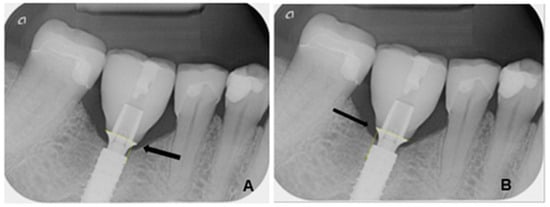
Figure 1
Open AccessArticle
Impact of Depressive Disorder on Periodontal Status: A Comparative Study
by
Bogdan-Constantin Vasiliu, Maria Alexandra Mârțu, Alexandra Cornelia Oanță, Irina Șufaru, Liliana Păsărin, Alexandru Ionuț Luchian and Sorina Mihaela Solomon
Dent. J. 2025, 13(9), 429; https://doi.org/10.3390/dj13090429 - 16 Sep 2025
Abstract
Background/Objectives. Periodontitis is a chronic inflammatory disease influenced by systemic and psychological factors, including depression. Selective serotonin reuptake inhibitors (SSRIs), widely used to treat depression, may also affect periodontal healing. This study aimed to evaluate the clinical efficacy of full-mouth disinfection (FMD)
[...] Read more.
Background/Objectives. Periodontitis is a chronic inflammatory disease influenced by systemic and psychological factors, including depression. Selective serotonin reuptake inhibitors (SSRIs), widely used to treat depression, may also affect periodontal healing. This study aimed to evaluate the clinical efficacy of full-mouth disinfection (FMD) in patients with periodontitis, with or without comorbid depression and SSRI therapy. Methods. Eighty participants were enrolled and divided into two groups: periodontitis only (n = 40) and periodontitis with depression (n = 40), the latter subgrouped by SSRI usage. Clinical parameters, including probing depth (PD), clinical attachment level (CAL), bleeding on probing (BOP), and plaque index (PI), were assessed at baseline and 12 weeks after FMD. Results. Following FMD, significant improvements were observed in PD, PI, and BOP across all groups (p < 0.001). In the non-depressed group, mean PD decreased from 4.26 ± 0.97 mm to 2.76 ± 0.56 mm (p < 0.001) and PI from 3.85 ± 0.70 to 1.05 ± 0.99. Patients with depression had higher initial PD (4.98 ± 1.05 mm) but still showed improvement to 3.08 ± 0.69 mm (p < 0.001). CAL improved significantly only in non-depressed individuals (p = 0.008), while no statistically significant CAL changes were observed in depressed patients (p > 0.05). SSRI therapy did not significantly influence treatment outcomes (p > 0.05). Conclusions. FMD is clinically effective in reducing periodontal inflammation in patients with or without depression. However, improvements in CAL were more pronounced in non-depressed individuals, suggesting that depression may partially attenuate periodontal healing.
Full article
(This article belongs to the Special Issue New Perspectives in Periodontology and Implant Dentistry)
►▼
Show Figures
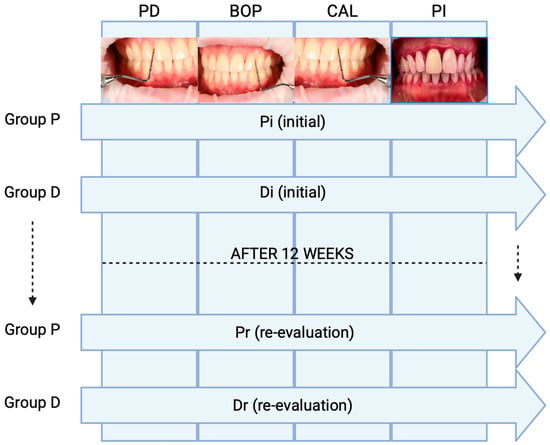
Figure 1
Open AccessArticle
The Effect of Simvastatin on Odontoblastic Differentiation of Human Dental Pulp Stem Cells: An In Vitro Study
by
Carmela Del Giudice, Flavia Iaculli, Carlo Rengo, Alessandro Salucci, Gianrico Spagnuolo, Francesco Riccitiello, Maurizio Bossù, Antonella Polimeni and Gianni Di Giorgio
Dent. J. 2025, 13(9), 428; https://doi.org/10.3390/dj13090428 - 16 Sep 2025
Abstract
Objectives: The aim of the current in vitro study was to assess the effect of simvastatin on the early-stage differentiation of human dental pulp stem cells (hDPSCs) in an odontogenic pattern by evaluating the expression of specific odontogenic-related genes. Methods: hDPSCs were cultured
[...] Read more.
Objectives: The aim of the current in vitro study was to assess the effect of simvastatin on the early-stage differentiation of human dental pulp stem cells (hDPSCs) in an odontogenic pattern by evaluating the expression of specific odontogenic-related genes. Methods: hDPSCs were cultured in the presence of different concentrations of simvastatin (0.1, 0.5, 1, 5, and 10 µM) to evaluate cytotoxicity. Moreover, osteogenic differentiation was assessed by Alkaline Phosphatase (ALP) activity and alizarin red staining (ARS) after 7 days of culture. Finally, odontogenic-related gene (OCN, MEPE, DSPP, and DMP-1) expression analysis was performed. Results: Three days after treatment, higher concentrations of simvastatin (1, 5, and 10 µM) significantly limited cell viability. Upregulation of ALP activity and odontoblastic cell-related genes (OCN and MEPE) was observed in the presence of 1 µM simvastatin. The expression was statistically higher for ALP (p = 0.0001) and OCN (p = 0.0231). On the other hand, comparable or slightly less effect concerning mineralization ability with respect to the control group, as well as in the expression of DSPP and DMP-1, was observed. Conclusions: Simvastatin demonstrated a positive influence on dentinogenesis by improving the expression of specific markers such as MEPE and OCN. However, its effect on inflammation reduction and the potential to be used in combination with other materials should be further assessed. Simvastatin might be successfully applied in the regeneration of damaged dental pulp tissues and promotion of reparative dentinogenesis. Additional studies should be carried out to support the obtained outcomes.
Full article
(This article belongs to the Special Issue Feature Papers in Restorative Dentistry, Endodontology and Traumatology)
►▼
Show Figures
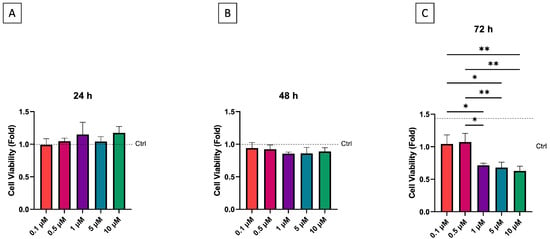
Figure 1
Open AccessArticle
Skeletal and Dentoalveolar Effects of the SOCIA III Appliance in Patients with Pseudo-Class III Malocclusion
by
Mauro Lorusso, Giovanna Jie Wang, Michele Tepedino, Angela Pia Cazzolla, Fariba Esperouz, Lucio Lo Russo and Domenico Ciavarella
Dent. J. 2025, 13(9), 427; https://doi.org/10.3390/dj13090427 - 15 Sep 2025
Abstract
►▼
Show Figures
Objective: This study aimed to assess the dentoskeletal and postural modifications induced by treatment with the Swallowing Occlusal Contact Intercept Appliance (SOCIA III) in patients with pseudo-Class III malocclusion. The main hypothesis was that treatment with the SOCIA appliance induces significant skeletal and
[...] Read more.
Objective: This study aimed to assess the dentoskeletal and postural modifications induced by treatment with the Swallowing Occlusal Contact Intercept Appliance (SOCIA III) in patients with pseudo-Class III malocclusion. The main hypothesis was that treatment with the SOCIA appliance induces significant skeletal and dentoalveolar changes in growing patients with pseudo-Class III malocclusion. Methods: Fifty-two pseudo-Class III malocclusion patients with a mean age of 8.5 were analyzed and compared with fifty-two untreated patients. Cephalometric evaluations were carried out at baseline (T0) and at the end of treatment. The cephalometric analysis comprised sagittal measurements (SNA, ANB, WITS, CB, ACB), dental variables (UI-PP, LI-MP, OVERJET, OVERBITE), and postural parameters (SNBa and cranio-cervical angle of the maxilla). Within-group comparisons at baseline (T0) and post-treatment (T1) were performed using the paired t-test or the Wilcoxon signed-rank test. Inter-group comparisons were based on the differences in variables between the two time points (ΔT1–T0), using the independent samples t-test or the Mann–Whitney U test. Results: At the end of treatment with the SOCIA appliance, significant improvements were observed in the ANB angle (0.61° to 2.06°, p = 0.001), SNA (81.56° to 83.26°, p = 0.006), WITS appraisal (−0.75 mm to 1.24 mm, p = 0.001), ACB angle (9.35 mm to 11.45 mm, p = 0.05), CB (64.78 mm to 65.51 mm, p = 0.03), and SNBa angle (127.57° to 129.14°, p = 0.01), as well as in overjet (0.62 mm to 3.60 mm, p = 0.001) and overbite (0.29 mm to 1.82 mm, p = 0.001). Conclusions: The SOCIA III appliance is effective in correcting pseudo-Class III malocclusion in growing patients by improving skeletal and dentoalveolar relationships.
Full article
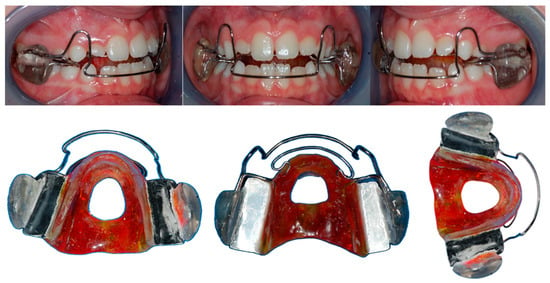
Figure 1
Open AccessSystematic Review
Effectiveness of Silica Coatings in Enhancing Resin Cement Adhesion to Zirconia: A Systematic Review
by
Laura C. Lara-Hernández, Luis C. Jiménez-Borrego and Nelly S. Roa
Dent. J. 2025, 13(9), 426; https://doi.org/10.3390/dj13090426 - 15 Sep 2025
Abstract
Background: The use of zirconia-based restorations has increased in dentistry due to their aesthetics, high strength, and biocompatibility. However, achieving durable adhesion between resin cements and zirconia remains a challenge in restorative dentistry. Adhesive failures can lead to complications ranging from dentin hypersensitivity
[...] Read more.
Background: The use of zirconia-based restorations has increased in dentistry due to their aesthetics, high strength, and biocompatibility. However, achieving durable adhesion between resin cements and zirconia remains a challenge in restorative dentistry. Adhesive failures can lead to complications ranging from dentin hypersensitivity to the loss of the restored tooth. This review evaluates the impact of surface treatments based on silica coatings as a strategy to improve the adhesion of resin cements to zirconia. Methods: A systematic review was conducted following PRISMA guidelines. Searches were performed in Scopus, Web of Science, PubMed, EBSCO, and ScienceDirect. In vitro studies were included if they (1) evaluated silica-based coatings on zirconia surfaces; (2) measured bond strength at the zirconia–cement interface through shear tests (MPa) and reported failure type (adhesive, cohesive, mixed); (3) used ≥8 specimens per group; and (4) included an untreated zirconia control group. Data were extracted and compared for conditions before and after thermocycling in the studies that reported this procedure. Results: The average bond strength for silica-coated zirconia was 15 MPa without thermocycling and 11.97 MPa after thermocycling, regardless of the coating technique. These values were significantly higher than those of untreated zirconia (8.45 MPa and 6.41 MPa, respectively). Cohesive and mixed failures predominated in silica-treated groups, suggesting more effective adhesion compared to controls, which presented mainly adhesive failures. Conclusions: Silica coatings, especially when combined with adhesion promoters, MDP-based primers, significantly enhance the bond strength of resin cements to zirconia. This reduces the risk of secondary caries, sensitivity, restoration debonding, and potential tooth fractures. However, the effectiveness of these coatings varies depending on the technique used, suggesting the need to standardize protocols to optimize clinical outcomes.
Full article
(This article belongs to the Topic Advances in Dental Materials)
►▼
Show Figures
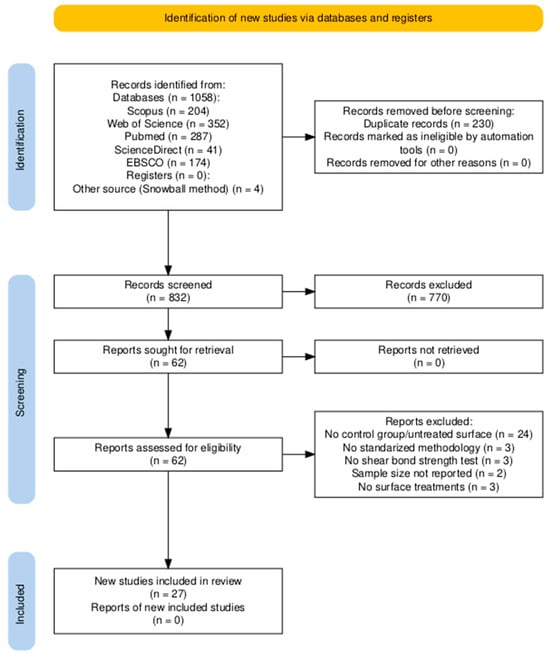
Figure 1
Open AccessArticle
Oral Health-Related Quality of Life, Behaviours and Oral Manifestations in a Paediatric Population with Type I Diabetes Mellitus: A Comparative Cross-Sectional Study
by
Patrícia João, Ana Coelho Canta and Sónia Mendes
Dent. J. 2025, 13(9), 425; https://doi.org/10.3390/dj13090425 - 15 Sep 2025
Abstract
Introduction: Type 1 diabetes mellitus (DM1) can influence oral health, increasing susceptibility to various oral manifestations. Objectives: This study aimed to characterise oral health-related quality of life (OHRQoL), reported oral symptoms, and oral health behaviours in paediatric individuals with DM1, and compare them
[...] Read more.
Introduction: Type 1 diabetes mellitus (DM1) can influence oral health, increasing susceptibility to various oral manifestations. Objectives: This study aimed to characterise oral health-related quality of life (OHRQoL), reported oral symptoms, and oral health behaviours in paediatric individuals with DM1, and compare them with those without DM1; as well as to identify factors associated with OHRQoL in both groups. Methods: A cross-sectional study was conducted using an online questionnaire completed by caregivers of Portuguese children with or without DM1. The questionnaire collected information on sociodemographic, oral health behaviours, perceived oral health, reported oral manifestations, and OHRQoL using the Early Childhood Oral Health Impact Scale (ECOHIS). Descriptive statistics were calculated, along with chi-square tests and negative binomial regression analyses (α = 0.05). Results: The sample included 235 individuals (115 with DM1 and 120 without). No significant differences were observed in overall OHRQoL between the groups, although children with DM1 had slightly higher ECOHIS total scores (4.38 vs. 4.02). Oral health behaviours were comparable in both groups. Children with DM1 reported significantly more xerostomia (p < 0.001). Within the DM1 group, better OHRQoL was significantly related to the following variables: female sex, absence of caries, absence of gingivitis, and no taste changes. In contrast, in the non-DM1 group, OHRQoL was associated with different conditions: the caregiver perception, frequent sugar intake, recurrent aphthous stomatitis, burning mouth sensations, and age. Conclusion: Although OHRQoL levels and oral health behaviours were similar between children with and without DM1, the factors influencing these outcomes varied considerably, emphasising the need for targeted oral health strategies tailored to the specific context of this chronic condition.
Full article
(This article belongs to the Special Issue Oral Health-Related Quality of Life and Its Determinants)
Open AccessReview
Emerging Metal Additive Manufacturing for Individualized Dental Therapies: A Narrative Review
by
Peng Chen, Taishi Yokoi, Ying-Sui Sun, Huiyong Yang and Hiroyasu Kanetaka
Dent. J. 2025, 13(9), 424; https://doi.org/10.3390/dj13090424 - 15 Sep 2025
Abstract
Metal additive manufacturing (AM) techniques, particularly laser powder bed fusion, are being increasingly recognized not as brand-new technologies, but as emerging technologies with their recent advancements—such as the development of optimized alloys, seamless digital workflow integration, and applications in patient-specific prostheses. With the
[...] Read more.
Metal additive manufacturing (AM) techniques, particularly laser powder bed fusion, are being increasingly recognized not as brand-new technologies, but as emerging technologies with their recent advancements—such as the development of optimized alloys, seamless digital workflow integration, and applications in patient-specific prostheses. With the rise in patient-specific approaches in dentistry, clinicians are seeking customized devices that precisely match individual anatomical and functional needs. AM offers various advantages, such as the fabrication of complex geometries directly from digital designs, enhanced clinical precision, reduced material waste, and simplified manufacturing workflow, and hence can uniquely address these demands. Recent advancements in AM techniques have led to the development of titanium and cobalt–chromium alloys with improved mechanical properties, corrosion resistance, and biological compatibility. These alloys show great potential for clinical applications. Additionally, AM enables precise control over the microstructures and surface topographies of these alloys during fabrication, facilitating their optimized integration with biological tissues. This mini review summarizes recent advancements in metal AM technologies relevant to personalized dentistry, highlights key material developments, discusses current clinical applications, and identifies key challenges such as high cost, materials limitations, and regulatory hurdles, and highlights future opportunities including multi-materials AM, smart implants, and AI-driven optimization for fully integrated, digitally driven personalized dental care.
Full article
(This article belongs to the Section Dental Materials)
►▼
Show Figures
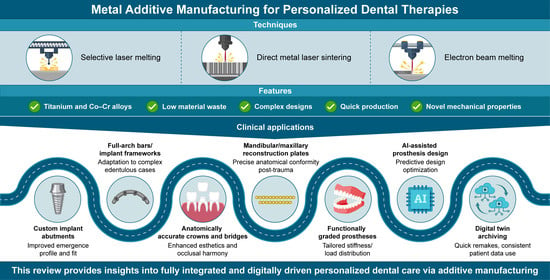
Graphical abstract
Open AccessArticle
Dental Staff Members’ Perception Regarding Objective Structured Clinical Examination (OSCE): An Experience from Saudi Arabia
by
Ahmad A. Alnazzawi
Dent. J. 2025, 13(9), 423; https://doi.org/10.3390/dj13090423 - 14 Sep 2025
Abstract
Background: The Objective Structured Clinical Examination (OSCE) is a widely used assessment tool in education in the health profession. Understanding faculty perceptions of the OSCE regarding fairness, validity, reliability, and effectiveness is essential to enhancing its implementation in dental education in Saudi Arabia.
[...] Read more.
Background: The Objective Structured Clinical Examination (OSCE) is a widely used assessment tool in education in the health profession. Understanding faculty perceptions of the OSCE regarding fairness, validity, reliability, and effectiveness is essential to enhancing its implementation in dental education in Saudi Arabia. Objective: To assess dental faculty members’ perceptions of the OSCE as an assessment method in Saudi Arabia, focusing on its fairness, reliability, validity, and effectiveness compared to other assessment formats. Methods: A cross-sectional analytical survey-based study was conducted among dental faculty members across 11 dental colleges in Saudi Arabia. A modified validated questionnaire was distributed electronically through the college deans to faculty members. Responses were analyzed using SPSS v25, applying descriptive and inferential statistics (chi-square test, significance set at p ≤ 0.05). Results: A total of 181 faculty responses from 11 Saudi dental colleges indicated broad support for the OSCE as a fair (78.3%), well-structured (71.1%), and comprehensive assessment of clinical skills (70%). While nearly half found it less stressful than other formats, 30% still perceived it as intimidating. Faculty agreed that OSCE tasks reflected taught content (65.9%), instructions were clear (75.7%), and scores were largely standardized and unbiased (63.9–72.9%). Compared with other assessment methods, essays/ short-answer questions (SAQs) were viewed as most effective for learning, but the OSCE was most favored for continued use in clinical training (52.8%). Conclusions: Faculty members in Saudi dental schools generally view the OSCE as a fair, valid, and effective assessment method. Despite concerns about student preparedness and perceived difficulty, the OSCE is endorsed as a key tool for evaluating clinical competencies. Addressing these concerns may further enhance its educational value and implementation.
Full article
(This article belongs to the Section Dental Education)
►▼
Show Figures

Graphical abstract
Open AccessReview
Breaking Barriers: Evaluating Challenges in Advancing Periodontal Ligament Cell-Derived Organoids
by
Luiza de Oliveira Matos, Mariane Beatriz Sordi, Anahid Ahmadi Birjandi, Paul Thomas Sharpe and Ariadne Cristiane Cabral Cruz
Dent. J. 2025, 13(9), 422; https://doi.org/10.3390/dj13090422 - 13 Sep 2025
Abstract
The objective of this review was to critically evaluate the available literature on the development of periodontal ligament organoids. Articles concerning periodontal ligament organoids were considered eligible. References were selected in a two-phased process. Electronic databases PubMed and Scopus were screened up to
[...] Read more.
The objective of this review was to critically evaluate the available literature on the development of periodontal ligament organoids. Articles concerning periodontal ligament organoids were considered eligible. References were selected in a two-phased process. Electronic databases PubMed and Scopus were screened up to June 2024, yielding 1101 studies. After removing duplicates, titles, and abstracts were screened, resulting in 44 articles being included in this review. A detailed analysis of the included articles was organized into four categories: (1) the cell lineages used, including the simultaneous use of two or more cell types, (2) the extracellular matrix composition, (3) the organoid preparation methods, and (4) the characterization techniques employed. The main findings show that collagen combined with biodegradable polymers—such as poly(caprolactone), poly(glycolic acid), and poly(lactic acid)—is the most used material. Periodontal ligament cells and periodontal fibroblasts were the most used cell types, due to their role in extracellular matrix remodeling. The most frequent analyses performed included alkaline phosphatase, extracellular matrix mineralization, and gene expression, providing insights into differentiation and periodontal regeneration. Cementogenic differentiation was the most studied, followed by osteogenic, chondrogenic, adipogenic, and epithelial differentiation. However, challenges remain, including methodological inconsistencies and the need for scaffold optimization. Future research should focus on standardizing protocols, improving biomaterials, and integrating bioprinting techniques to improve clinical translation.
Full article
(This article belongs to the Special Issue Regenerative Approaches in Dental Sciences)
►▼
Show Figures

Figure 1
Open AccessArticle
Digital Accuracy of Closed-Tray Implant Impressions: Influence of Polyvinyl Siloxane Viscosity and Subgingival Posterior Implant Angulation
by
Yousra Ahmed, Shereen Moselhy Abdul Hameed, Zainab Refaey El Sharkawy, Faris A. Alshahrani, Tarek AbdAllah Mahmoud, Inas M. Mohamed and Noha Taymour
Dent. J. 2025, 13(9), 421; https://doi.org/10.3390/dj13090421 - 12 Sep 2025
Abstract
►▼
Show Figures
Objectives: To assess the impact of PVS impression material viscosity and implant angulation on the three-dimensional accuracy of implant casts in a partially edentulous situation using the closed-tray technique. Materials and Methods: Three epoxy resin mandibular partially edentulous models (Kennedy Class I)
[...] Read more.
Objectives: To assess the impact of PVS impression material viscosity and implant angulation on the three-dimensional accuracy of implant casts in a partially edentulous situation using the closed-tray technique. Materials and Methods: Three epoxy resin mandibular partially edentulous models (Kennedy Class I) were fabricated, each with four implant analogues placed at teeth positions 35, 37, 45, and 47. The anterior analogues were positioned parallel (0), while the posterior analogues were placed at different angulations: Group 1, 30° mesiodistal; Group 2, 20° mesiodistal; Group 3, 20° buccolingual. All analogues were placed 2 mm subgingivally. Closed-tray impressions (n = 8 per subgroup) were made using either heavy + light body PVS or monophase PVS. Resulting stone casts were scanned, and STL files were processed and analyzed using reverse engineering software (Geomagic Control X). Three-dimensional deviations (root mean square, RMS) between reference and test models were calculated by superimposition and best-fit algorithm. Results: With monophase PVS, implant angulation significantly influenced cast accuracy (p < 0.001). The 30° MD group exhibited the highest deviation (96 ± 7 µm), followed by the 20° BL group (81 ± 6 µm), then the 20° MD group (75 ± 6 µm). In contrast, no statistically significant difference in accuracy was observed among angulation groups when using heavy + light body PVS (77 ± 3 µm, 82 ± 13 µm, and 79 ± 8 µm for 30° MD, 20° BL, and 20° MD, respectively; p = 0.550). Conclusions: Both monophase and heavy + light body PVS impression materials produced clinically acceptable accuracy for closed-tray implant impressions. However, the heavy + light body PVS demonstrated greater consistency across various implant angulations and is recommended for multiple angulated subgingival posterior implants when using the closed-tray technique.
Full article

Figure 1
Open AccessArticle
Comparison of Narrow (<3.75 mm) and Standard (≥3.75 mm) Diameter Implants Supporting the Same Multiple Fixed Prostheses and Mirroring Real-World Clinical Scenarios: Non-Randomized Clinical Trial
by
Eduardo Anitua, Ander Alcaine and Mohammad Hamdan Alkhraisat
Dent. J. 2025, 13(9), 420; https://doi.org/10.3390/dj13090420 - 12 Sep 2025
Abstract
►▼
Show Figures
Objective: To compare the survival of narrow (<3.75 mm) implants and standard diameter (≥3.75 mm) implants supporting the same multiple fixed prostheses and mirroring real-world clinical scenarios. Methods: This is a controlled clinical trial where both test (diameter < 3.75 mm) and control
[...] Read more.
Objective: To compare the survival of narrow (<3.75 mm) implants and standard diameter (≥3.75 mm) implants supporting the same multiple fixed prostheses and mirroring real-world clinical scenarios. Methods: This is a controlled clinical trial where both test (diameter < 3.75 mm) and control (diameter ≥ 3.75 mm) implants supported the same prosthesis. The principal variable was implant survival and the secondary variables included demographic, surgical and prosthetic variables. Statistical analyses were conducted to compare these variables between the study groups. Results: A total of 42 patients participated in this study, with an age range of 39 to 92 years. The follow-up period was 36 months. Narrow diameter implants (NDIs) were predominantly placed in the premolar region and more frequently in bone types I and II compared to wider diameter implants. No implant failures were recorded during the study period. Marginal bone level remodeling showed statistically significant differences between the study groups at 12-month follow-up. However, these differences were no longer significant after 3 years of follow-up (Test: median −0.2 mm, range −1.5 to 0.8 mm; Control: median 0.0 mm, range −1.3 to 0.8 mm; p = 0.119). None of the prostheses failed, and all remained free of technical complications throughout the study. Conclusions: Within the limitations of this study, narrow-diameter implants demonstrated comparable clinical outcomes to standard-diameter implants when supporting the same prostheses.
Full article

Figure 1
Open AccessArticle
Crown–Root Ratio as a Predictive Morphometric Indicator in Mandibular First Molars with Occlusal Trauma and Periodontitis: A Radiographic and Clinical Modeling Study
by
Lidya Irani Nainggolan, Bramma Kiswanjaya, Menik Priaminiarti, Sri Lelyati Chaidar Masulili, Hanna H. Bachtiar-Iskandar, Yuniarti Soeroso, Pitu Wulandari, Eha Renwi Astuti and Akihiro Yoshihara
Dent. J. 2025, 13(9), 419; https://doi.org/10.3390/dj13090419 - 12 Sep 2025
Abstract
►▼
Show Figures
Background/Objectives: Trauma from occlusion (TFO) is a modifying factor in periodontal disease progression, yet its morphometric impact on mandibular molars remains underexplored. The crown–root ratio (CRR), traditionally used in prosthodontic prognosis, may also serve as a diagnostic marker for structural changes in periodontally
[...] Read more.
Background/Objectives: Trauma from occlusion (TFO) is a modifying factor in periodontal disease progression, yet its morphometric impact on mandibular molars remains underexplored. The crown–root ratio (CRR), traditionally used in prosthodontic prognosis, may also serve as a diagnostic marker for structural changes in periodontally compromised teeth. This study evaluated the relationship between crown and root dimensions and clinical/radiographic parameters in mandibular first molars with TFO and developed predictive models emphasizing the role of CRR. Methods: This retrospective cross-sectional study included 99 periodontitis patients clinically and radiographically diagnosed with TFO. Digitized periapical radiographs of mandibular first molars (tooth 36 or 46) were analyzed to measure clinical and radiographic CRR, crown and root length, tooth inclination, alveolar bone loss, and root morphology. Correlation and stepwise multiple regression analyses identified predictors of crown and root length. Results: Males had significantly greater crown length (7.6 vs. 7.2 mm), root length (13.3 vs. 12.3 mm), and radiographic CRR (1.2 vs. 1.0) (p = 0.008). Clinical CRR showed a moderate positive correlation with crown length (r = 0.526) and a strong inverse correlation with root length (r = −0.735) (p < 0.001). Regression models revealed that clinical CRR, root length, and sex significantly predicted crown length (R2 = 0.955), while CRR and crown length predicted root length (R2 = 0.958). Conclusions: This study demonstrated that the clinical crown–root ratio (CRR) is a strong predictor of both crown and root lengths in mandibular first molars affected by trauma from occlusion (TFO) in periodontitis patients.
Full article

Graphical abstract
Open AccessArticle
Comparative Usability Evaluation of Three Digital Smile Design Software Tools Using the System Usability Scale
by
Andrei Macris, Sergiu Drafta, Ștefania Martiniuc and Alexandru E. Petre
Dent. J. 2025, 13(9), 418; https://doi.org/10.3390/dj13090418 - 12 Sep 2025
Abstract
Background/Objectives: Digital Smile Design software tools facilitates aesthetic planning and improves communication between clinicians, patients, and dental laboratories. These software tools have been developed to support facial and dental analysis and to assist users in creating an ideal smile integrated with the patient’s
[...] Read more.
Background/Objectives: Digital Smile Design software tools facilitates aesthetic planning and improves communication between clinicians, patients, and dental laboratories. These software tools have been developed to support facial and dental analysis and to assist users in creating an ideal smile integrated with the patient’s appearance. This study aimed to compare the usability of three DSD software tools—Preteeth AI Pro (version 6.0.0), SmileCloud, and Medit Link (version 3.4.3)—using the System Usability Scale. Methods: Twenty-three prosthodontists and prosthodontics residents evaluated each tool following a standardized usage protocol. After completing Digital Smile Designs in each application, participants filled out a 10-item System Usability Scale questionnaire (score 0–100). Descriptive statistics were calculated, and intergroup comparisons were performed using one-way ANOVA (p < 0.05). Results: Mean System Usability Scale scores were 74.24 (Preteeth AI Pro), 80.33 (SmileCloud), and 73.15 (Medit Link). SmileCloud obtained the highest score (A−grade, Curved Grading Scale), indicating “good to very good” usability. No statistical significances were found between the three software tools (F = 1.04, p = 0.36). Conclusions: All three Digital Smile Design software tools achieved System Usability Scale scores above the usability benchmark of 68, with SmileCloud demonstrating the most favorable user experience. These findings may assist clinicians in selecting intuitive and efficient Digital Smile Design platforms to optimize aesthetic treatment workflows.
Full article
(This article belongs to the Special Issue Advances in Esthetic Dentistry)
►▼
Show Figures

Figure 1
Open AccessArticle
Synergistic Effect of Sodium Hypochlorite and Carbon Dioxide Against Enterococcus faecalis Biofilm
by
Júlia Guerra de Andrade, Ana Flávia Folhas Natali, Caroline Loureiro, Gladiston William Lobo Rodrigues, Ana Paula Fernandes Ribeiro, Rayara Nogueira de Freitas, Renan Jose Barzotti, Laura Cesário Oliveira, Yuri Gabriel Chamorro de Moraes, Natália Amanda Gomes, Antônio Hernandes Chaves-Neto, Frederico Canato Martinho and Rogério de Castilho Jacinto
Dent. J. 2025, 13(9), 417; https://doi.org/10.3390/dj13090417 - 10 Sep 2025
Abstract
Objectives: This study aimed to evaluate whether the addition of pressurized carbon dioxide (PCD) influences the antimicrobial efficacy of 2.5% sodium hypochlorite (NaOCl) against Enterococcus faecalis biofilm in root canals and dentinal tubules. Methods: Forty extracted human mandibular premolars with single canals were
[...] Read more.
Objectives: This study aimed to evaluate whether the addition of pressurized carbon dioxide (PCD) influences the antimicrobial efficacy of 2.5% sodium hypochlorite (NaOCl) against Enterococcus faecalis biofilm in root canals and dentinal tubules. Methods: Forty extracted human mandibular premolars with single canals were contaminated with E. faecalis for 10 days and randomly assigned to four groups (n = 10): 2.5% NaOCl, 2.5% NaOCl + CO2, sterile saline, and sterile saline + CO2. The pH and temperature of the NaOCl solution were measured before and after CO2 incorporation. Microbial load was assessed by CFU counts before and after irrigation, and in dentin samples from the cervical, middle, and apical thirds. Oxidative stress was evaluated via lipid peroxidation (TBARS), protein carbonyl content, and total protein quantification. Biofilm metabolic activity was analyzed using the XTT reduction assay. Data were analyzed using one-way ANOVA on ranks and two-way repeated measures ANOVA (α = 0.05), a very large effect size (Cohen’s d) ≈ 1.756 was assumed. Results: All irrigation protocols significantly reduced bacterial load (p < 0.05). Both NaOCl groups outperformed the saline controls (p = 0.009). The addition of CO2 to NaOCl slightly enhanced disinfection in the main canal but did not improve antimicrobial action in dentinal tubules. CO2 incorporation reduced the pH of NaOCl from ~13.4 to 7.4 and slightly increased the temperature, making the solution more chemically reactive. However, both oxidative stress markers and the XTT assay showed that the combination with CO2 impaired the antimicrobial effectiveness of NaOCl. Conclusions: Despite the improvement in bacterial reduction in the root canal lumen, the combination of PCD with NaOCl failed to enhance intratubular disinfection and reduced the oxidative damage and metabolic inactivation of the biofilm. CO2 pressurization appears to limit the antimicrobial action of NaOCl.
Full article
(This article belongs to the Special Issue Oral Microbiology and Related Research)
►▼
Show Figures

Graphical abstract
Open AccessSystematic Review
Laser Therapy for Vascular Malformations of the Oral Cavity: A Systematic Review
by
Matteo Pellegrini, Martina Bosisio, Federica Pulicari, Carmen Darinca Todea and Francesco Spadari
Dent. J. 2025, 13(9), 416; https://doi.org/10.3390/dj13090416 - 9 Sep 2025
Abstract
Objectives: to compare the clinical effectiveness, safety, and aesthetic outcomes of different laser systems used for the treatment of oral vascular malformations. Materials and Methods: This review followed JBI guidelines and adhered to the PRISMA (Preferred Reporting Items for Systematic Reviews
[...] Read more.
Objectives: to compare the clinical effectiveness, safety, and aesthetic outcomes of different laser systems used for the treatment of oral vascular malformations. Materials and Methods: This review followed JBI guidelines and adhered to the PRISMA (Preferred Reporting Items for Systematic Reviews and Meta-Analyses) 2020 statement. The research was performed through the databases PubMed, Scopus, and Web of Science using MeSH (Medical Subject Headings) terms for MEDLINE (PubMed), while equivalent free-text terms were applied to Scopus and Web of Science. The initial database search was performed on 20 May 2024. Studies published from 2014 to 2024 focusing on laser therapy for oral vascular lesions were included. Data quality was assessed using NHLBI and ROBINS-I V2 tools. Results: Of the 139 articles identified, 11 met inclusion criteria, assessing Nd:YAG, diode, Er,Cr:YSGG, and CO2 lasers. The Nd:YAG laser was effective for deep vascular lesions with strong thermal effects. The diode laser provided excellent coagulation and minimal postoperative discomfort. The Er,Cr:YSGG laser offered faster healing and better cosmetic results. The CO2 laser showed effective results with low recurrence rates. Most studies reported reduced bleeding, pain, and recovery time following laser treatment. Conclusions: Laser therapy, particularly Nd:YAG, diode, and CO2 lasers, offers a safe, effective alternative for oral vascular malformations, providing improved outcomes and fewer complications. Future studies should include larger sample sizes and comparisons with traditional therapies.
Full article
(This article belongs to the Special Issue Editorial Board Members’ Collection Series: Laser in Oral Surgery, Diagnosis and Oncology)
►▼
Show Figures

Graphical abstract

Journal Menu
► ▼ Journal Menu-
- Dentistry Journal Home
- Aims & Scope
- Editorial Board
- Reviewer Board
- Topical Advisory Panel
- Instructions for Authors
- Special Issues
- Topics
- Sections & Collections
- Article Processing Charge
- Indexing & Archiving
- Editor’s Choice Articles
- Most Cited & Viewed
- Journal Statistics
- Journal History
- Journal Awards
- Conferences
- Editorial Office
Journal Browser
► ▼ Journal BrowserHighly Accessed Articles
Latest Books
E-Mail Alert
News
19 September 2025
MDPI Webinar | The Science Behind the Prize: 2025 Nobel Physiology or Medicine Roundtable, 6 October 2025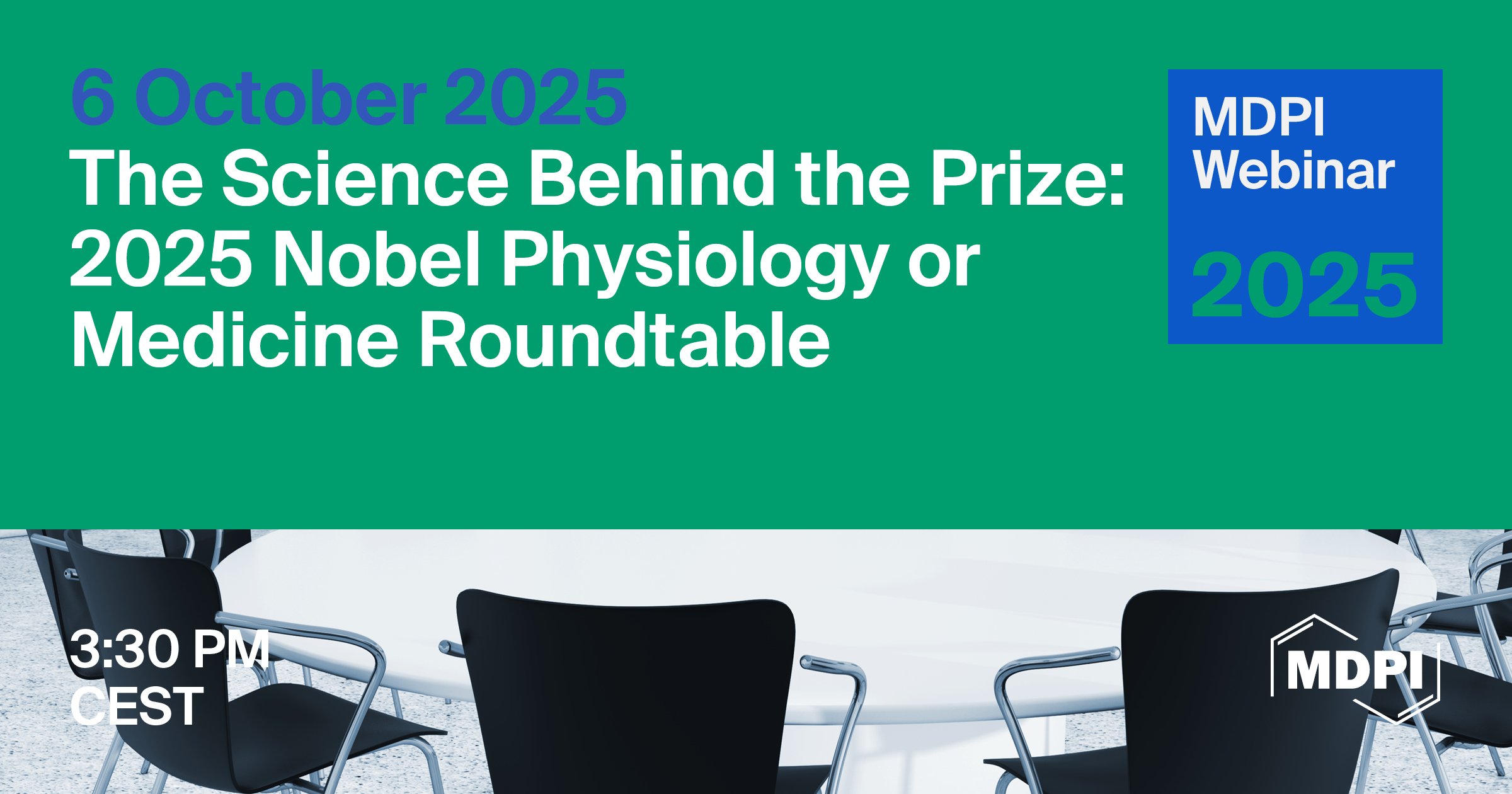
MDPI Webinar | The Science Behind the Prize: 2025 Nobel Physiology or Medicine Roundtable, 6 October 2025

3 September 2025
Join Us at the MDPI at the University of Toronto Career Fair, 23 September 2025, Toronto, ON, Canada
Join Us at the MDPI at the University of Toronto Career Fair, 23 September 2025, Toronto, ON, Canada

Topics
Topic in
Dentistry Journal, JCM, Materials, Biomedicines, Life
Medical and Dental Care, Photobiomodulation and Photomedicine
Topic Editors: Samir Nammour, Chukuka Samuel Enwemeka, Aldo Brugnera JuniorDeadline: 31 December 2025
Topic in
Applied Sciences, Children, Dentistry Journal, JCM
Preventive Dentistry and Public Health
Topic Editors: Denis Bourgeois, Elena BardelliniDeadline: 30 April 2026
Topic in
Biology, JCM, Diagnostics, Dentistry Journal
Assessment of Craniofacial Morphology: Traditional Methods and Innovative Approaches
Topic Editors: Nikolaos Gkantidis, Carlalberta VernaDeadline: 1 June 2026
Topic in
Dentistry Journal, IJMS, JCM, Medicina, Applied Sciences
Oral Health Management and Disease Treatment
Topic Editors: Christos Rahiotis, Felice Lorusso, Sergio Rexhep TariDeadline: 31 July 2026

Conferences
Special Issues
Special Issue in
Dentistry Journal
Bone Regeneration and Tissue Reconstruction in Dentistry
Guest Editor: Juho SuojanenDeadline: 30 September 2025
Special Issue in
Dentistry Journal
Digital Implantology in Dentistry
Guest Editors: Paolo Carosi, Claudio ArcuriDeadline: 30 September 2025
Special Issue in
Dentistry Journal
3D Printing and Restorative Dentistry
Guest Editor: Neamat Hassan AbubakrDeadline: 20 October 2025
Special Issue in
Dentistry Journal
Dental Materials Design and Innovative Treatment Approach
Guest Editors: Patrizio Bollero, Francesco GianfredaDeadline: 20 October 2025
Topical Collections
Topical Collection in
Dentistry Journal
Novel Ceramic Materials in Dentistry
Collection Editors: Roberto Sorrentino, Gianrico Spagnuolo
Topical Collection in
Dentistry Journal
Bio-Logic Approaches to Implant Dentistry
Collection Editors: Luigi Canullo, Donato Antonacci, Piero Papi, Francesco Gianfreda, Bianca Di Murro, Carlo Raffone
Topical Collection in
Dentistry Journal
Dental Traumatology and Sport Dentistry
Collection Editor: Enrico Spinas










